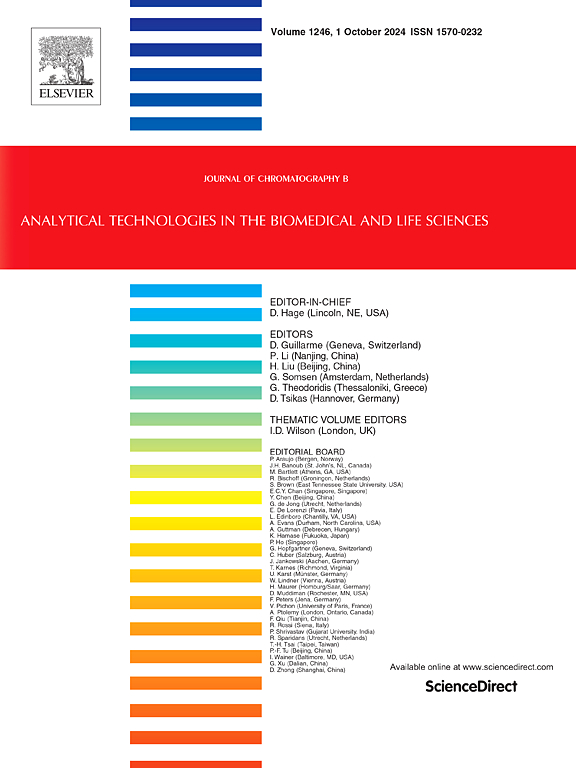Pharmacokinetic and tissue distribution analysis of sporoderm-removed Ganoderma lucidum spore powder in rats
IF 2.8
3区 医学
Q2 BIOCHEMICAL RESEARCH METHODS
引用次数: 0
Abstract
Ganoderma lucidum (Lingzhi), a medicinal mushroom, is recognized for its broad pharmacological activities, including potential health and longevity benefits. Notably, several triterpenoids derived from its spores and fruiting body have demonstrated anti-inflammatory, anti-tumor, and immunomodulatory effects. Despite their therapeutic promise, pharmacokinetic parameters and tissue distribution profiles of these bioactive components are not well characterized, representing a significant knowledge gap. This study aims to elucidate the pharmacokinetic characteristics and tissue distribution patterns of major triterpenoids in sporoderm-removed Ganoderma lucidum spore powder (RGLSP) in rats, thereby laying the groundwork for further optimization of these natural products. We established an ultra-performance liquid chromatography-multiple reaction monitoring-mass spectrometry (UPLC-MRM-MS) method to quantify 12 triterpenoids in rat plasma and tissues following oral administration of RGLSP. The method was validated according to US Food and Drug Administration bioanalytical guidelines and demonstrated good performance. Pharmacokinetic analysis revealed that the mean time to peak concentration for the 12 triterpenoids ranged from 0.25 to 2.33 h, with maximum concentrations varying from 42.52 to 643.13 ng/mL and the area under the concentration-time curve spanning 72.74 to 943.00 ng·h/mL. Tissue distribution results indicated rapid and extensive distribution of the triterpenoids in rat liver, lung, spleen, kidney, heart, and gastrointestinal tract, followed by gradual metabolism. After oral administration, major triterpenoids in RGLSP were rapidly absorbed into the plasma and widely distributed across five major viscera and the gastrointestinal tract, undergoing hepatic and intestinal circulation through metabolic pathways. These findings provide a valuable reference for the clinical application of RGLSP, as well as lead optimization of the triterpenoids.
去孢子粉在大鼠体内的药动学及组织分布分析
灵芝(灵芝)是一种药用蘑菇,因其广泛的药理活性而被公认,包括潜在的健康和长寿益处。值得注意的是,从其孢子和子实体中提取的几种三萜具有抗炎、抗肿瘤和免疫调节作用。尽管它们具有治疗前景,但这些生物活性成分的药代动力学参数和组织分布特征并没有很好地表征,这代表了一个重大的知识差距。本研究旨在阐明去孢灵芝孢子粉(RGLSP)中主要三萜在大鼠体内的药动学特征和组织分布规律,为进一步优化这些天然产物奠定基础。建立了超高效液相色谱-多重反应监测-质谱(UPLC-MRM-MS)方法,定量大鼠口服RGLSP后血浆和组织中12种三萜的含量。根据美国食品和药物管理局的生物分析指南对该方法进行了验证,并证明了良好的性能。药代动力学分析表明,12种三萜化合物的平均峰浓度时间为0.25 ~ 2.33 h,最大浓度范围为42.52 ~ 643.13 ng/mL,浓度-时间曲线下面积为72.74 ~ 943.00 ng·h/mL。组织分布结果表明,三萜类化合物在大鼠肝脏、肺、脾、肾、心脏和胃肠道中分布迅速、广泛,并逐渐代谢。口服后,RGLSP中的主要三萜被迅速吸收到血浆中,并广泛分布于五大脏器和胃肠道,通过代谢途径进入肝脏和肠道循环。这些发现为RGLSP的临床应用提供了有价值的参考,同时也为三萜类化合物的优化提供了指导。
本文章由计算机程序翻译,如有差异,请以英文原文为准。
求助全文
约1分钟内获得全文
求助全文
来源期刊

Journal of Chromatography B
医学-分析化学
CiteScore
5.60
自引率
3.30%
发文量
306
审稿时长
44 days
期刊介绍:
The Journal of Chromatography B publishes papers on developments in separation science relevant to biology and biomedical research including both fundamental advances and applications. Analytical techniques which may be considered include the various facets of chromatography, electrophoresis and related methods, affinity and immunoaffinity-based methodologies, hyphenated and other multi-dimensional techniques, and microanalytical approaches. The journal also considers articles reporting developments in sample preparation, detection techniques including mass spectrometry, and data handling and analysis.
Developments related to preparative separations for the isolation and purification of components of biological systems may be published, including chromatographic and electrophoretic methods, affinity separations, field flow fractionation and other preparative approaches.
Applications to the analysis of biological systems and samples will be considered when the analytical science contains a significant element of novelty, e.g. a new approach to the separation of a compound, novel combination of analytical techniques, or significantly improved analytical performance.
 求助内容:
求助内容: 应助结果提醒方式:
应助结果提醒方式:


